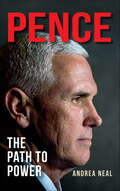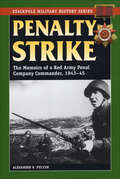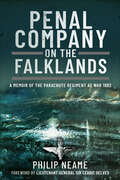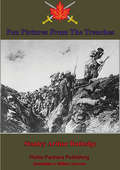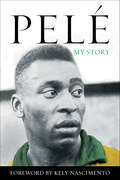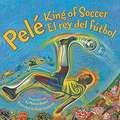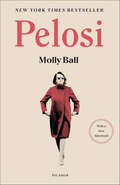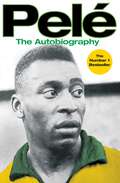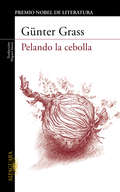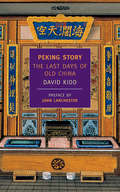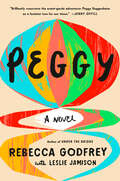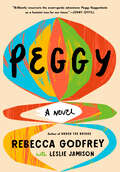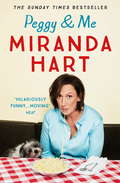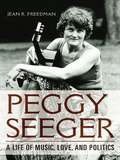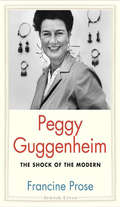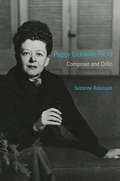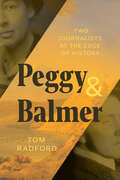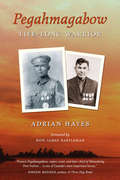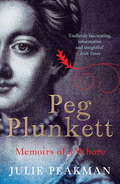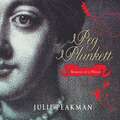- Table View
- List View
Pencils, Pens & Brushes: A Great Girls' Guide to Disney Animation
by Mindy JohnsonBased on Mindy Johnson's critically acclaimed Disney Editions title, Ink & Paint: The Women of Walt Disney's Animation, this nonfiction picture book is a fun and inspiring look at many of the amazing women who have worked at Disney Animation over the years—from Story Artists, to Animators to Inkers and Painters, all with unique personalities and accomplishments, such as becoming a record-holding pilot, or designing Hollywood monsters, or creating an international club for tall people!
Pence: The Path to Power
by Andrea NealWhat does a person need to learn before they can survive as the vice president under a tumultuous administration? How do you continue to honor the laws and the constitution of the country in the face of increasingly vitriolic partisan politics? Mike Pence's vice presidency of the United States wasn't always easy. To some, he is the personification of American conservative values, but to others, his ideals are the epitome of prejudice and bigotry. In Pence: The Path to Power, journalist Andrea Neal showcases how the vice president arrived at this position of influence. Neal interviews friends, family, staff, former teachers, and politicians on both sides of the aisle to reveal a multifaceted view of the self-described Christian, Conservative, and Republican–in that order–from his beginnings in a large Irish Catholic family in Columbus, Indiana, through the scandals of his first election, to his time beside Donald Trump. This candid look at Mike Pence's life exposes his unexpected path to power and the individuals who influenced him along the way.
Penalty Strike: The Memoirs of a Red Army Penal Company Commander, 1943–45 (Stackpole Military History Series)
by Alexander V Pyl'cynA WWII Soviet officer recalls leading a battalion of convict-soldiers in this rare firsthand account of a Red Army penal unit. Alexander Pyl&’cyn was eighteen years old when he was drafted into the Red Army in 1941. He went on to serve with great distinction, earing the Order of the Red Banner, the Order of the Great Patriotic War, and the Order of the Red Star for his actions during the war. As the commander of a penal battalion on the Eastern Front, he led an unruly band of convict-soldiers, Gulag prisoners, and former Soviet POWs deemed untrustworthy. Relegated to the most difficult and dangerous assignments, Pyl&’cyn&’s unit was called up to break through the enemy&’s defenses. He led his penal unit through the Soviets&’ massive offensive in the summer of 1944, the Vistula-Oder operation into eastern Germany, and the bitter assault on Berlin in 1945. Though his men suffered massive casualties, and he himself withstood multiple wounds, he survived the war to tell this incredible story.
Penal Company on the Falklands: A Memoir of the Parachute Regiment at War 1982
by Philip NeameOn 1 April 1982 the Argentinian junta invaded the Falkland Islands, while the 2nd Battalion the Parachute Regiment was on leave. Recalled to barracks, it joined the hastily assembled task force to recover the Islands. No parachutes – instead a journey of 8000 miles on a North Sea ferry to deliver the battalion into battle. Philip Neame commanded D Company, one of the battalion’s three 100-strong rifle companies, and in this compelling book he tells their story. 2 PARA was commanded by Lieutenant Colonel ‘H’ Jones, who was awarded a posthumous Victoria Cross at the Battle of Goose Green. After winning the first major land battle on the Falklands, 2 PARA were the only battalion to fight two, going on to fight at Wireless Ridge, the final gateway to Port Stanley. D Company played the decisive role, but, in the closing moments, suffered a deadly artillery barrage – from their own guns. D Company was the Cinderella of 2 PARA, at the back for everything: on training, always in reserve; in barracks, the parking lot for those who proved too troublesome for A and B. It was nicknamed ‘Penal Company’. This searingly honest but humorous account explores the realities of war – the tightrope between success and disaster, comedy and tragedy; the strength of companionship and the solitude of fear. Above all, it is a tribute to a band of brothers who, taking their nickname as a badge of honor, fought, cursed and laughed together, to win through on those ‘ringing plains of windy Troy.’
Pen Pictures From The Trenches
by Stanley Arthur RutledgeStanley Arthur Rutledge was a man of many parts: lawyer, beloved son, soldier, man of letters before his life was cut tragically short on the 16th November 1917. A member of the famed Canadian Corps, he left his home shore in 1915 and served courageously until dying in a flying accident whilst trained for the Royal Flying Corps.This volume is divided into two parts: the first contains notes, anecdotes and experiences that the Author wrote whilst in the trenches through the battles of the Western Front, including the Somme. In them he describes the daily shelling, sniper fire, deadly poison gas, going over the top and even a sentry shooting one of his own officers who didn't hear his challenge. The second part is made up of his letters home to his parents in Canada describing his experiences in the "Hippodrome of Hell" of the war. In spite of his audience, he pulled no punches in his retellings...An excellent First World War Memoir.Author -- Stanley Arthur Rutledge d. 1917Text taken, whole and complete, from the edition published in Toronto, William Briggs, 1918.Original Page Count - 159 pages.
Pen & Palate: Mastering the Art of Adulthood, with Recipes
by Tram Nguyen Lucy MadisonFrom the writers of acclaimed blog Pen & Palate, a humorous coming-of-age (and mastering-the-art-of-home-cooking) memoir of friendship, told through stories, recipes, and beautiful illustrations. Getting through life in your twenties isn't easy--especially if you're broke, awkward, and prone to starting small grease fires in your studio apartment. For best friends Lucy Madison and Tram Nguyen, cooking was an escape from the daily humiliation that is being a twenty-something woman in a big city. PEN & PALATE traces the course of Lucy and Tram's devoted friendship through miserable jobs and tiny apartments, first loves and ill-advised flings, successes and setbacks--always with a shared love of food at the center of the narrative. A modern take on Laurie Colwin's classic Home Cooking, this coming-of-age memoir for the Girls set weaves together comical (mis)adventures and recipes meant to be shared with a best friend and a bottle of wine.
Pelé: My Story
by Pelé"For an American soccer kid growing up in the ‘80s, Pelé transcended the game. From the moment I first saw him standing next to Sylvester Stallone and Michael Caine in Victory, there was only one star for me on that screen. Pelé's exciting memoir revives all the groundbreaking moments of the best there ever was." —Alexi Lalas, journalist, retired professional US soccer player The man. The legend. The autobiography. Even people who don’t know soccer know Pelé, the universally acknowledged best player of all time. Born Edson Arantes do Nascimento, “Pelé” was the youngest player to score a goal in and win the World Cup at age seventeen, the only player to win the World Cup three times, and the all-time goal scorer for Brazil. His international career helped introduce soccer to Americans, and he popularized describing the sport as “the beautiful game.” But how did this man become a global icon? In Pelé: My Story, Pelé shares in his own words the story of his incredible life and career. Told with his characteristic charm and humility, and covering all aspects of his playing days and his subsequent careers as politician, international sporting ambassador, and cultural icon, this book is the essential volume for all sports fans, and anyone who admires true rarity of spirit.
Pelé: King of Soccer / El rey del fútbol (Into Reading, Read Aloud Module 10 #2)
by Monica Brown Fernando Gayesky Rudy GutiérrezNIMAC-sourced textbook <P><P>Monica Brown and Rudy Gutierrez team up to deliver what Kirkus called, in a starred review, an “inspiring blend of art and story,” about the most famous soccer star in the world, Pelé. This bilingual picture book will inspire, teach, and amaze readers as they learn about the man who revolutionized the sport of soccer. <P><P>Do you know how a poor boy from Brazil who loved fútbol more than anything else became the biggest soccer star the world has ever known? This is the true story of Pelé, King of Soccer, the first man in the history of the sport to score a thousand goals and become a living legend. Rudy Gutierrez’s dynamic illustrations make award-winning author Monica Brown’s story of this remarkable sports hero come alive! <P><P>Lexile Measure: 730
Pelosi
by Molly BallNEW YORK TIMES BESTSELLER A riveting inside account of the unprecedented rise to power and unmatched political legacy of the first woman Speaker of the House, by award-winning journalist Molly Ball Nancy Pelosi’s opposition to Donald Trump has made her an icon of the Resistance, featured in viral memes clapping sardonically at the president or ripping up his State of the Union address. But the real Nancy Pelosi is neither the shrill partisan featured in thousands of attack ads nor the cautious corporatist reviled by the far left. She’s the rare politician who still knows how to get big things done—a master of legislative power whose policy accomplishments have touched millions of American lives, from providing universal access to health care to reforming Wall Street to allowing gay people to serve openly in the military. She’s done it all at a time of historic polarization and gridlock, despite being routinely underestimated by allies and opponents alike.Ball’s nuanced, page-turning portrait takes readers inside Pelosi’s life and times, from her roots in urban Baltimore to her formative years as a party activist and fundraiser, from the fractious politics of San Francisco to high-stakes congressional negotiations with multiple presidents. The result is a compelling portrait of a barrier-breaking woman that sheds new light on American political history. Based on exclusive interviews with the Speaker and deep background reporting, Ball shows Pelosi through a thoroughly modern lens to explain how this extraordinary woman has met her moment.
Pele: The Autobiography
by PeleThe SUNDAY TIMES number 1 bestseller -- the extraordinary life story of the greatest footballer ever to play the game.
Pelando la cebolla
by Günter GrassEl libro más polémico del Premio Nobel de Literatura Günter Grass «El recuerdo se asemeja a una cebolla que quisiera ser pelada para dejar al descubierto lo que, letra por letra, puede leerse en ella.» Pelando la cebolla es un extraordinario ejercicio de memoria en el que Günter Grass se pregunta sin autocomplacencia y con absoluta sinceridad por los sucesos que marcaron los primeros años de su vida. Desde su niñez en Danzig, su incorporación a la Waffen SS, su trabajo como minero sobre los escombros de aquella Alemania de posguerra, hasta su exilio en París, donde escribirá a lo largo de dos durísimos años El tambor de hojalata. Este libro es la narración de una vida intensa y es, a la vez, una honesta confesión en la que Günter Grass plantea cómo el no preguntar supone una forma de compromiso. Las páginas de Pelando la cebolla gozan de una frescura y fuerza genuinas que nos invitan a adentrarnos en la obra de un escritor que ya es uno de los clásicos indiscutidos de la literatura actual. La crítica ha dicho...«Preciso y auténtico. Describe sin vergüenza, pero lleno de dudas, el surgimiento de un artista, una piel de cebolla tras otra.»Die Zeit «El libro es mucho más y mucho menos que una confesión. Tiene mucho que contar.»Frankfurter Allgemeine Zeitung «Grass ha logrado una obra maestra literaria, temáticamente cautivadora, estilísticamente muy artística y despiadadamente abierta.»Stuttgarter Zeitung «Un cariñoso retrato familiar, una sensacional obra.»Der Spiegel «En Pelando la cebolla hay muchos pasajes que cautivan al lector con una fuerza inconfundible.»Der Tagesspiegel
Peking Story
by John Lanchester David KiddFor two years before and after the 1948 Communist Revolution, David Kidd lived in Peking, where he married the daughter of an aristocratic Chinese family. "I used to hope," he writes, "that some bright young scholar on a research grant would write about us and our Chinese friends before it was too late and we were all dead and gone, folding into the darkness the wonder that had been our lives." Here Kidd himself brings that wonder to life.
Peggy: A Novel
by Rebecca GodfreyA dazzling, richly imagined novel about Peggy Guggenheim—a story of art, family, love, and becoming oneself, by the award-winning author of Under the Bridge "Brilliantly resurrects the avant-garde adventurer Peggy Guggenheim as a feminist icon for our times." —Jenny OffillVenice, 1958. Peggy Guggenheim, heiress and now legendary art collector, sits in the sun at her white marble palazzo on the Grand Canal. She's in a reflective mood, thinking back on her thrilling, tragic, nearly impossible journey from her sheltered, old-fashioned family in New York to here: iconoclast and independent woman.Rebecca Godfrey&’s Peggy is a blazingly fresh interpretation of a woman who defies every expectation to become an original. The daughter of two Jewish dynasties, Peggy finds her cloistered life turned upside down at fourteen, when her beloved father perishes on the Titanic. His death prompts Peggy to seek a life of passion and personal freedom, and, above all, to believe in the transformative power of art. We follow Peggy as she makes her way through the glamorous but sexist and anti-Semitic art worlds of New York and Europe and meet the numerous men who love her (and her money) while underestimating her intellect, talent, and vision. Along the way, Peggy must balance her loyalty to her family with her need to break free from their narrow, snobbish ways and from the unexpected restrictions that come with vast fortune.In a tour de force of imagination and insight, Rebecca Godfrey's final book—completed by her friend, the acclaimed writer Leslie Jamison, following Godfrey's death in 2022—brings to life the woman who helped make the Guggenheim name synonymous with art and genius.
Peggy: A Novel
by Rebecca GodfreyA dazzling, richly imagined novel about Peggy Guggenheim—a story of art, family, love, and becoming oneself—by the award-winning author of Under the Bridge, now a Hulu limited series starring Riley Keough and Lily Gladstone&“Godfrey brilliantly resurrects the avant-garde adventurer Peggy Guggenheim as a feminist icon for our times.&”—Jenny Offill, author of Dept. of Speculation&“Magnificent . . . Readers will be won over by Godfrey&’s incandescent portrait of a singular woman.&”—Publishers Weekly, starred reviewVenice, 1958. Peggy Guggenheim, heiress and now legendary art collector, sits in the sun at her white marble palazzo on the Grand Canal. She&’s in a reflective mood, thinking back on her thrilling, tragic, nearly impossible journey from her sheltered, old-fashioned family in New York to here: iconoclast and independent woman.Rebecca Godfrey&’s Peggy is a blazingly fresh interpretation of a woman who defies every expectation to become an original. The daughter of two Jewish dynasties, Peggy finds her cloistered life turned upside down at fourteen, when her beloved father perishes on the Titanic. His death prompts Peggy to seek a life of passion and personal freedom and, above all, to believe in the transformative power of art. We follow Peggy as she makes her way through the glamorous but sexist and anti-Semitic art worlds of New York and Europe and meet the numerous men who love her (and her money) while underestimating her intellect, talent, and vision. Along the way, Peggy must balance her loyalty to her family with her need to break free from their narrow, snobbish ways and the unexpected restrictions that come with vast fortune.Rebecca Godfrey&’s final book—completed by her friend, the acclaimed writer Leslie Jamison, following Godfrey&’s death in 2022—brings to life the woman who helped make the Guggenheim name synonymous with art and genius.
Peggy and Me: The heart-warming bestselling tale of Miranda and her beloved dog
by Miranda HartThe hilarious and heartwarming memoir of Miranda and her life changing dog, the inimitable and most lovable Peggy.Hello dear book browser and welcome to Peggy and Me. The story of my life since getting a beautiful Shih-Tzu Bichon Frise cross puppy (I call the breed a Shitty Frise - fun) in the form of Peggy.Some of you may be thinking: "a book about a dog, how totally brilliant, I need hear no more, I'm sold." In which case we should be best friends and go out to tea together, every day.Others of you may be thinking: "a book about a dog, how totally mad, she must have officially lost it." In which case I completely understand. For I once viewed dog owners with much suspicion. The way they obsessively talk about their dogs often using voices for them to reply; the way they have a light covering of dog hair all over their clothes and sofas; and worse, an alarming comfort and ease around excrement. But I now get why people become so mad about their hounds. It wasn't instant love I have to admit. Getting a puppy when I was at a low ebb in my life wasn't easy - there was a lot of challenging, what I call, dog administration (dog-min), and the humiliating first trip to the vet still haunts me. It's been a bumpy old road, but Peggy has been lovingly by my side through some life changing moments and I wouldn't have coped without her. Most surprisingly she has taught me a huge amount - not how to get an old pie packet out of a bin and lick it (I could already do that), but real lessons about life and love and trust and friendship. Put aside any doggy reservations and come walkies with Peggy and me...
Peggy and Me: The heart-warming bestselling tale of Miranda and her beloved dog
by Miranda HartFROM NATIONAL TREASURE and star and creator of the award-winning BBC sitcom Miranda, comes Miranda Hart's heart-warming and hilarious account of life with her beloved dog Peggy, a gorgeous white bichon frise.'Hilariously funny and often moving memoir ... we loved every word *****' Heat'Open, honest ... her misadventures are hilariously described ... charming and funny' Daily Express* * * * * * * * * * * * * * * *Hello dear book browser and welcome to Peggy & Me, the story of my life since getting a beautiful Shih-Tzu Bichon Frise cross puppy (I call the breed a Shitty Frise - fun) in the form of Peggy.Some of you may be thinking: "a book about a dog, how totally brilliant, I need hear no more, I'm sold." In which case we should be best friends and go out to tea together, every day.Others of you may be thinking: "a book about a dog, how totally mad, she must have officially lost it." In which case I completely understand. For I once viewed dog owners with much suspicion. The way they obsessively talk about their dogs often using voices for them to reply; the way they have a light covering of dog hair all over their clothes and sofas; and worse, an alarming comfort and ease around excrement. But I now get why people become so mad about their hounds. It wasn't instant love I have to admit. Getting a puppy when I was at a low ebb in my life wasn't easy - there was a lot of challenging, what I call, dog administration (dog-min), and the humiliating first trip to the vet still haunts me. It's been a bumpy old road, but Peggy has been lovingly by my side through some life-changing moments and I wouldn't have coped without her. Most surprisingly she has taught me a huge amount - not how to get an old pie packet out of a bin and lick it (I could already do that), but real lessons about life and love and trust and friendship. Put aside any doggy reservations and come walkies with Peggy and me ...
Peggy and Me: The heart-warming bestselling tale of Miranda and her beloved dog
by Miranda HartThe hilarious and heartwarming account of Miranda and her life changing dog, the inimitable and most lovable Peggy.Hello dear audiobook browser and welcome to Peggy and Me. The story of my life since getting a beautiful Shih-Tzu Bichon Frise cross puppy (I call the breed a Shitty Frise - fun) in the form of Peggy.Some of you may be thinking: "a book about a dog, how totally brilliant, I need hear no more, I'm sold." In which case we should be best friends and go out to tea together, every day.Others of you may be thinking: "a book about a dog, how totally mad, she must have officially lost it." In which case I completely understand. For I once viewed dog owners with much suspicion. The way they obsessively talk about their dogs often using voices for them to reply; the way they have a light covering of dog hair all over their clothes and sofas; and worse, an alarming comfort and ease around excrement. But I now get why people become so mad about their hounds. It wasn't instant love I have to admit. Getting a puppy when I was at a low ebb in my life wasn't easy - there was a lot of challenging, what I call, dog administration (dog-min), and the humiliating first trip to the vet still haunts me. It's been a bumpy old road, but Peggy has been lovingly by my side through some life changing moments and I wouldn't have coped without her. Most surprisingly she has taught me a huge amount - not how to get an old pie packet out of a bin and lick it (I could already do that), but real lessons about life and love and trust and friendship. Put aside any doggy reservations and come walkies with Peggy and me...(P) 2016 Hodder & Stoughton
Peggy Seeger: A Life of Music, Love, and Politics
by Jean R. FreedmanBorn into folk music's first family, Peggy Seeger has blazed her own trail artistically and personally. Jean Freedman draws on a wealth of research and conversations with Seeger to tell the life story of one of music's most charismatic performers and tireless advocates. Here is the story of Seeger's multifaceted career, from her youth to her pivotal role in the American and British folk revivals, from her instrumental virtuosity to her tireless work on behalf of environmental and feminist causes, from wry reflections on the U.K. folk scene to decades as a songwriter. Freedman also delves into Seeger's fruitful partnership with Ewan MacColl and a multitude of contributions which include creating the renowned Festivals of Fools, founding Blackthorne Records, masterminding the legendary Radio Ballads documentaries, and mentoring performers in the often-fraught atmosphere of The Critics Group. Bracingly candid and as passionate as its subject, Peggy Seeger is the first book-length biography of a life set to music.
Peggy Guggenheim
by Francine ProseOne of twentieth-century America's most influential patrons of the arts, Peggy Guggenheim (1898-1979) brought to wide public attention the work of such modern masters as Jackson Pollock and Man Ray. In her time, there was no stronger advocate for the groundbreaking and the avant-garde. Her midtown gallery was the acknowledged center of the postwar New York art scene, and her museum on the Grand Canal in Venice remains one of the world's great collections of modern art. Yet as renowned as she was for the art and artists she so tirelessly championed, Guggenheim was equally famous for her unconventional personal life, and for her ironic, playful desire to shock. Acclaimed best-selling author Francine Prose offers a singular reading of Guggenheim's life that will enthrall enthusiasts of twentieth-century art, as well as anyone interested in American and European culture and the interrelationships between them. The lively and insightful narrative follows Guggenheim through virtually every aspect of her extraordinary life, from her unique collecting habits and paradigm-changing discoveries, to her celebrity friendships, failed marriages, and scandalous affairs, and Prose delivers a colorful portrait of a defiantly uncompromising woman who maintained a powerful upper hand in a male-dominated world. Prose also explores the ways in which Guggenheim's image was filtered through the lens of insidious antisemitism.
Peggy Glanville-Hicks: Composer and Critic (Music in American Life)
by Suzanne RobinsonAs both composer and critic, Peggy Glanville-Hicks contributed to the astonishing cultural ferment of the mid-twentieth century. Her forceful voice as a writer and commentator helped shape professional and public opinion on the state of American composing. The seventy musical works she composed ranged from celebrated operas like Nausicaa to intimate, jewel-like compositions created for friends. Her circle included figures like Virgil Thomson, Paul Bowles, John Cage, and Yehudi Menuhin. Drawing on interviews, archival research, and fifty-four years of extraordinary pocket diaries, Suzanne Robinson places Glanville-Hicks within the history of American music and composers. "P.G.H."--affectionately described as "Australian and pushy"--forged alliances with power brokers and artists that gained her entrance to core American cultural entities such as the League of Composers, New York Herald Tribune, and the Harkness Ballet. Yet her impeccably cultivated public image concealed a private life marked by unhappy love affairs, stubborn poverty, and the painstaking creation of her artistic works. Evocative and intricate, Peggy Glanville-Hicks clears away decades of myth and storytelling to provide a portrait of a remarkable figure and her times.
Peggy & Balmer: Two Journalists at the Edge of History
by Tom Radford“Alberta is a puzzle, born in hope and anger,” William Thorsell writes in the introduction to this stunning new book by filmmaker and writer Tom Radford. Following the lives of his grandparents Peggy and Balmer Watt, Radford tells the story of two journalists who arrive in Edmonton the first day of the province's life, September 1, 1905, as Prime Minister Wilfred Laurier announces Alberta as the great hope for "Canada's Century" that lies ahead. But Albertans already have a contrary vision in mind, a government strong enough to challenge the constitution that binds them. Peggy and Balmer find themselves in the midst of a conflagration that will last a century - their marriage falls apart, their newspapers go bankrupt, and Alberta veers towards the extremist politics of today. Balmer defends the freedom of the press and helps win the first Pulitzer awarded outside the United States. Peggy chronicles her own story, "A Woman in the West." Seen from our time, the lives of these two remarkable journalists introduce the angels and devils of Alberta history - the siren call of a Last Best West that once again jeopardizes Canada's future.
Pegahmagabow: Life-Long Warrior
by Adrian HayesFrancis Pegahmagabow was a remarkable aboriginal leader who served his nation in time of war and his people in time of peace. In wartime he volunteered to be a warrior. In peacetime he had no option. His life reveals how uncaring Canada was about those to whom this land had always been home. A member of the Parry Island band (now Wasauksing First Nation) near Parry Sound, Ontario, Francis served with the Canadian Expeditionary Force in Belgium and France for almost the entire duration of the First World War, primarily as a scout and sniper. Through the horrific battles and inhumane conditions of trench warfare, his actions earned him three decorations for bravery — the most ever received by a Canadian aboriginal soldier. More recently, they inspired the central fictional character in Joseph Boyden’s highly acclaimed novel Three Day Road. Physically and emotionally scarred by his wartime ordeals, Francis returned to Parry Island to try to rebuild his life. He had been treated as an equal in the army, but quickly discovered things hadn’t changed back in Canada. As a status Indian his life was regulated by the infamous Indian Act and by local Indian agents who seemed bent on thwarting his every effort to improve his lot. So, Francis became a warrior once more — this time in the even longer battle to achieve the right of aboriginal Canadians to control their own destiny. In compiling this account of Francis Pegahmagabow’s remarkable life, Adrian Hayes conducted extensive research in newspapers, archives, and military records, and spoke with members of Pegahmagabow’s family and others who remembered the plight and the perseverance of this warrior.
Peg Plunkett: Memoirs of a Whore
by Julie Peakman'Of picking, washing and cleaning my pretty little toes, which he took great delight in, and in which pleasurable, innocent, and inoffensive pastime he as often spent hours; 'twas the greatest gratification to him on earth, nor did he (said she) indulge in any other in all the time we spent together, he never was even rude enough to give me a kiss.' So emerged the first exposé of foot fetishism in the eighteenth century. Revelations and racy anecdotes about the lives of the rich and famous of Dublin and London abound within Peg Plunkett: Memoirs of a Whore. From a violent domestic background, Peg blitzed her way through balls and masquerades creating scandals and gossip wherever she went, leaving dukes, barristers and lieutenants stranded in her wake. She was the first madame ever to write her memoirs, thereby setting the template for the whore's memoir. She wrote not merely to reveal herself but to expose the shoddy behaviour of others and her account of her life. In Peg Plunkett: Memoirs of a Whore, Julie Peakman brings her subject and the world through which she moved to glorious, bawdy life.
Peg Plunkett: Memoirs of a Whore
by Julie PeakmanOf picking, washing and cleaning my pretty little toes, which he took great delight in, and in which pleasurable, innocent, and inoffensive pastime he as often spent hours; twas the greatest gratification to him on earth, nor did he (said she) indulge in any other in all the time we spent together, he never was even rude enough to give me a kiss.So emerged the first expose of foot fetishism in the eighteenth-century. Revelations and racy anecdotes about the lives of the rich and famous of Dublin and London abound within Peg Plunkett: Memoirs of a Whore.From a violent domestic background, Peg blitzed her way through balls and masquerades creating scandals and gossip wherever she went, leaving dukes, barristers and lieutenants stranded in her wake. She was the first madame ever to write her memoirs, thereby setting the template for the whore's memoir. She wrote not merely to reveal herself but to expose the shoddy behaviour of others and her account of her life. In Peg Plunkett: Memoirs of a Whore, Julie Peakman brings her subject and the world through which she moved to glorious, bawdy life.(P)2015 WF Howes Ltd

